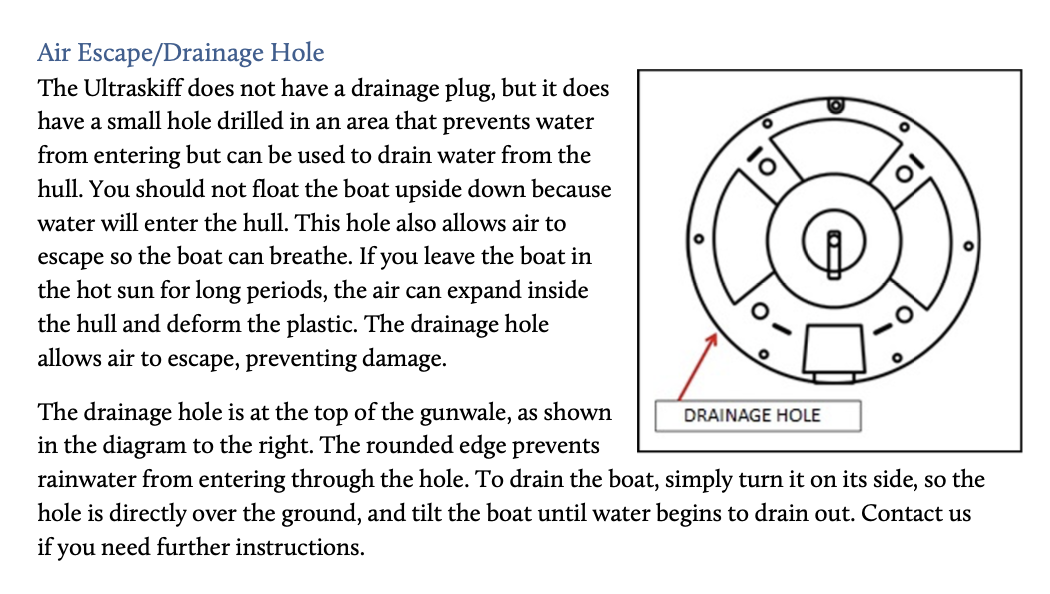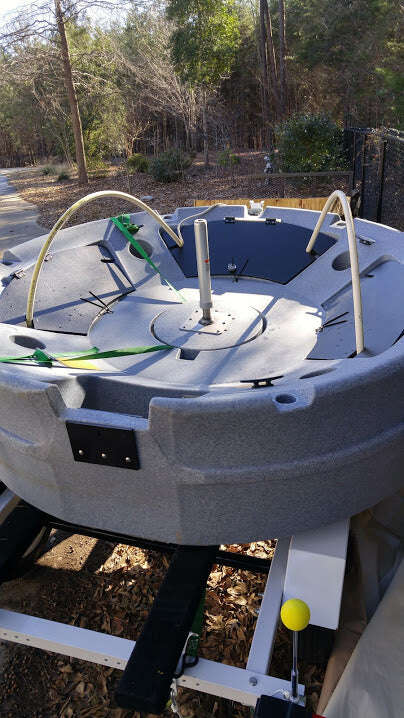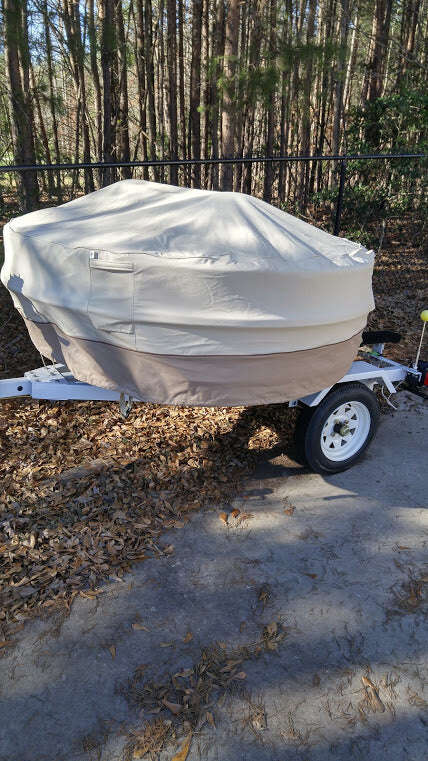Ultraskiff FAQs
We have assembled every question we have received related to the Ultraskiff on this page with detailed answers to each one ranking in order of prevalence.
How long will a battery last with a trolling motor?
Batteries do not lose power when you’re anchored and not running the motor, but running the motor continuously is different and is the only way you can gauge “run time”. The amount of motor thrust is the key factor that determines this. Below is a pretty accurate approximation taken from www.trollingmotors.net. This information is if you left the motor running at that speed continuously and never turned it off. So with a 55Lb thrust motor you can get about 20 hours at low speed, 6 hours continuous run time at Medium speed and about 2.5 hours of continuous run time at maximum speed. There are a lot of variables like battery health involved of course, but from my experience it seems pretty accurate. I have found that running the motor at half speed or below pulls so little amp draw it barely factors into your overall usage. I can make a normal day of fishing on a single battery last anywhere from 12 hours when I am anchoring on most spots to 4 hours when I am in windy conditions with the motor running most of the time. It all depends on how much you use the motor and the amount of thrust you apply to those periods of usage. With some experience comes efficiency and confidence in your motor usage. The 55 lb Endura Max has a battery status meter on it, so you can keep an eye on how much battery power is left with just the push of a button.
I’m a big guy, how will the Ultraskiff handle me?
Here is a video of a 375 pound gentlemen trying out the Ultraskiff for the first time at the 2016 Tampa Florida Sportsman Expo. He also shared his honest opinion of how stable he felt and what this experience is like for someone of his size. This Demo and review is unpaid and unscripted.
What does the Ultraskiff draft? What is the Max Capacity?
The weight capacity of the Ultraskiff is 360 lbs. With a 200 lb man on it, along with a trolling motor, battery and gear, the skiff drafts about 3-4 inches.
What is the purpose of the flared bow?
The strategically flared bow prevents water from splashing up while giving the boat the lift it needs to get through and over large swells.
Do you ship products directly to the consumer?
Do we have different colors?
We tested every color, grey granite is the best color if you want to keep the re-sale value of the boat after a lot of use. I have been using my first sample since day one and I still use it. It’s the one in the videos. These boats are designed to get beat up, scratched, bloodied and stained. The white specks hide the scratches and the dark specks hide the stains. Scratches on polyethylene plastic are always white, so unless you want your plastic boat to look like an old trash can, the grey granite is the right choice.
What about a duck blind, sun shades, solar panels or other specialty accessories?
On our Accessories Video Page you can find a wealth of videos on making custom rod holders, , sun shades, duck blinds, and more. Outdoors-men and Frontierswomen are handy and crafty, it’s a natural fit for a lot of our PVC build videos. What’s nice about the skiff is that it has 6 equally distance rod holders that you can put 1 1/4″ or 1 1/2″ PVC into it and build all kinds of things!
Can you outfit the boat with manual or powered pole anchor system?
Yes. A manual Pin or Pole anchor system works great. All you have to do is push it through the Tow Ring on the Bow of the boat and you are good to go. Our Anchor pin slot allows the pole to slide freely up and down in rough water or as you move around. It works well to keep the anchor Pin laying on the deck across the strap guides, in one of the rod holders attached to the seat, or with some PVC holders mounted to any of the molded rod holders.
Power-poles are not recommended because they remain vertical while not deployed, and are very much in the way while you are fishing. They also eliminate your ability to roll or slide the boat, and it’s better to keep the boat as light as possible for moving around.
Can I install a fish-finder or depth finder on an Ultraskiff 360?
Ram Mounts and Ram Balls are mountable over any of the skiff’s cleats. You can also detach the cleats which will leave two machine screw inserts that are about 1 3/8″ apart. If the Fish Finder Screen Mount doesn’t match these holes, then you can just use one screw and it works fine. Or you can use a wood plank or make a single PVC unit that has the screen and transducer on one unit. The sonar/transponder can be attached to any of the bottom utility inserts, the front tow ring, to your trolling motor, to the transom or fed through the drainage channel and center hole of the boat. Check out our Accessories Video Page to see videos demonstrating these options.
Does the boat come with a warranty? How is it manufactured?
Yes, the boat comes with a 1 year manufacturer’s limited warranty. This boat is rotationally molded as 1 solid durable piece, no glued or riveted seams. The attachments and accessories are screwed into 33 brass and stainless steel mold-in inserts.
Do we make or are we planning a 2-seat option?
Although of course possible we do not feel that having 2 seats is a logical idea for several reasons listed below, our opinion is that after considering all the disadvantages you would be better served buying a small boat if you are looking for a 2 person boat.
1. It is counter-productive to the very purpose of a round boat. The whole idea is that you are positioned in the center and have an equal 360 vantage point and and equal foot positioning and posture as you turn in your chair. 2 seats defeats this purpose.
2. The “T-cup Effect” Related to the 360 vantage point as the boat drifts and ambiently turns in the water both seats are rotated making it difficult to stay facing any particular target unless firmly anchored down from 2 separate points.
3. Weight imbalance: If one person weighs more the the other then boat will be tilted towards the heavier occupant, making sitting uncomfortable for both passengers. This also makes exiting and entering the boat one occupant at a time pretty tricky.
4. Limited speed: The one draw back to these non-planning round hulls is that they are not engineered for speed and displace a large amount of water. Therefore especially if you use a trolling motor keeping the weight to a minimum enable you to attain an acceptable speed and battery life for regular use. Adding another occupant cuts down your speed and battery life essentially in half.
Does the Ultraskiff have a drain if water gets inside the hull?
Yes, there is a one way drain hole on the rounded gunwale that strategically allows water to leave the hull.

Does the Ultraskiff have drains in the compartments?
No, and here is why: The bottom of the compartments are lower then the waterline, so the idea of a compartment that drains out is just a misleading and dishonest lie. If you had a drain that lead water outside of the boat, then water would fill them up not drain them out. If you get rained on, you may get a small amount of water to creep inside the compartments, but you have to get the water out of the utility pockets and rod holders anyway by standing it upright, so there is no point in allowing water to collect inside your boat. It’s just an extra step of work since the water falls out instantly when you stand it up.
It is not recommended and will void any warranty if any holes are drilled into the Ultraskiff hull.
Do I need a cover for the Ultraskiff?
It depends on how you store your boat. If you are keeping it outside, we recommend standing it vertically against a fence or flipping it upside down so you don’t need a cover.
If you are leaving the boat flat on a trailer outside and don’t want to flip it upside down, then a cover would be useful to keep the Utility Pockets/Cup Holders from becoming a nice mosquito breeding pool. Although a tarp works, round fitted 72″ table covers also work well.
If you want a completely covered boat and want to prevent water from pooling in the center, you can place to sections of PVC like the photos show below.



How much does the boat weigh?
The assembled boat hull weighs 123 lbs.
Can you use a foot-controlled trolling motor?
While you can, we do not recommend it compared to a tiller motor.
The steering of the Ultraskiff is sensitive in nature and just does not match up with a foot control mainly because you have to put the pedal back to “12:00” each time you want to go straight and unfortunately there is no way to see where 12:00 is with your foot.
Even with the pedal in different areas of the boat it is much more convenient to move your hand to adjust the tiller than it is to find a pedal with your foot. The whole essence of a round boat is that you don’t have to face a certain way to operate the boat. Controlling with your foot sort of takes all of that away by forcing you to face a certain direction to steer.
Also, you don’t realize that the tiller is only inches away from you at all times until you actually use an Ultraskiff yourself. Moving your arm to adjust the steering is much easier and more comfortable rather than having to look down, turn in the chair and be forced to face a certain way to touch the pedal each time you need to move.
How easy is it to move, launch and transport the Ultraskiff 360 by hand?
The Ultraskiff 360 weighs 123 lbs. It has 2 handles for lifting and handling underneath the bow. Our favorite way to move the boat is by rolling it on its side. It takes a little bit to master it, but once you do, you’ll end up wanting to roll it everywhere!
Another good method is sliding the boat on it’s side. If you have a surface that is not course, then you can easily slide the boat around. It slides well because the only parts that touch the ground are the edge of the roll bar and the edge of the rounded gunwales, so there is minimum resistance.
A common hand truck is another great way to move the boat on land and launch from shorelines and beaches.
How easy is it to move, launch and transport the Ultraskiff 360 by vehicle?
The back of any pick-up truck bed is the perfect method. Even with a short bed you can strap them down horizontally or vertically. The center hole makes securing them with just one ratchet strap easy! For vertical transporting 2 straps are recommended.
If you’re transporting by car, any small utility or watercraft trailer works well, or they make hitch mounted carriers such as the Harbor Freight Wheel Chair Carrier.
How is the Ultraskiff 360 in rough conditions and passing wake from large boats?
The Ultraskiff 360 can handle wake from passing boats very well. Here is a video demonstrating boat wake trials.
Can I use a gas-powered motor?
Yes you can, but it is coast-guard rated for 2.0 hp or lower. The 17″ transom allows you to use a short shaft outboard, but a gas motor is very jerky and the torque from the gas motor turns/spins at a high rate of speed.
Unfortunately, the craft is just too short and wide to be a planing hull. It navigates like a barge, therefore your top speed is limited to about 4 mph. The only time you can efficiently convert your power into speed is when you have an even waterline from bow to stern.
With a trolling motor the skiff always moves smooth and at an even water line. A standard deep cycle battery powered transom mounted trolling motor is the best and safest choice for the Ultraskiff 360 in our opinion.
Do I need a life preserver when using the Ultraskiff 360?
You need whatever your state and coast guard regulations require.
How does the boat track and steer?
Round Boats can be sensitive to steer at first, but a little practice goes a long way. It is actually a great attribute when in tight spaces. If you look at the bottom of the boat you will see that it is only a round boat on top. The bottom half of the hull has a large pointed prow like other boats. This prow and the skegs underneath is what gives the tracking ability.
Can I paddle an Ultraskiff 360?
Yes, if something happens you can paddle by kneeling on the front of the round boat. A collapsible emergency paddle should be kept in one of the compartments when you are boating alone just in case something happens to your motor. It also has a rod holder on each side of the chair, and if outfitted correctly could be used as oar locks. The bottom of the Ultraskiff is still a boat with a large pointed prow so paddling is better than you would think in a round boat.
Can I use one of the storage compartments as a cooler?
Yes, you can fill it with ice and stock it with drinks or fish. But we strongly recommend using a Cooler Bag if it’s hot out. These are inexpensive items that will preserve your ice much longer and make clean up afterwards much easier. Also, there is no automatic drainage inside the compartments, so a cooler bag will allow you to empty the water at will.
Can I use one of the storage compartments as a live well?
Yes, the compartments can be used as a live well with an aerator, bilge or as a re-circulating live-well. Bilge-pumps can be used to pump water in and out. But, there is no easier or more convenient way to keep live bait with you than just using a flow troll. Use 2 of them and tie one on each of the rear cleats so they drag evenly behind the boat. If you turn one of the compartments into a re-circulating bait well, all you need to do is add water and your own aeration and circulation device — running a bubble or aerator pump inside should do the trick. If you want to pump fresh water inside, there are long open slots on each side of the compartment doors for this exact reason. You can run the hose(s) over the side of the boat while keeping the doors closed. These slots also let you run ropes and anchor lines inside the compartments while the doors are closed.
Does the boat come with a Title?
Yes, The boat comes with a Manufacturer’s Certificate of Origin (MCO) and a Hull Identification Number (HIN). If you are a Texas resident, we will fill out the title paperwork and turn it into the title office for you. If you’re out of state, we’ll provide the paperwork for you to take to your local registration office and take care of any sales tax/titling fees that are required.
What if I need to register my Ultraskiff 360 in my state?
Typically, all motorized watercraft have to be titled and registered in their state of use. Some may not require it if the boat is only using a trolling motor as the primary propulsion. Many states do not require a boat to be registered if you’re using it on a private lake or pond. Check with your local authorities to see what’s required in your state.
How to add Registration Stickers to the Ultraskiff
Polyethylene plastic is a “Low energy” plastic and it makes it difficult to paint over it and attach adhesive stickers to it. The Registration Sticker usually sticks better than the letter stickers. Although most our customers just stick them all right onto the hull without a problem, a Low Energy Vinyl wrap or sticker is a great choice to apply to the hull then add stickers on top of it. Another option is to spray the area with 3M high strength adhesive spray (#76 or #90). Another good adhesive for polyethylene plastic is the 3M Scotch Weld High performance industrial plastic adhesive 4693H.
If you want to permanently stencil your numbers onto the boat, you could use a permanent black marker. But be aware that it makes it difficult, or nearly impossible to ever remove the traces of these numbers from the hull.
